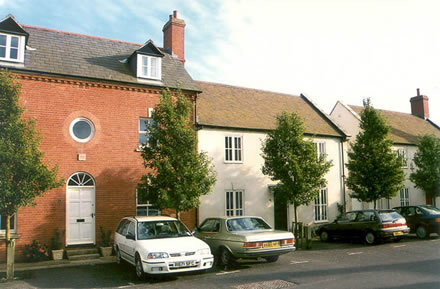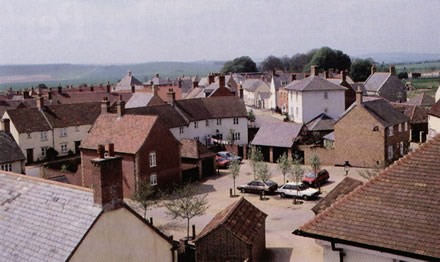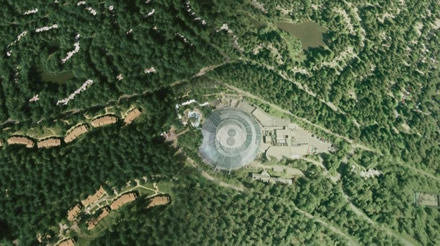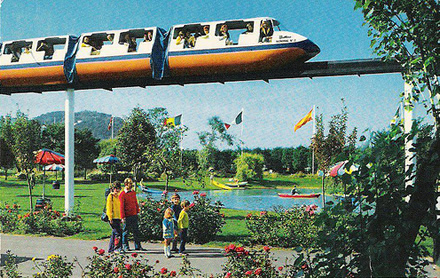
Gordon Brown's "legacy" project of building 10 eco-towns in the South East of England is an endeavour of specious rhetoric, of mobilised Nimbyism, and unfettered hyperbole.
There seems to be nobody willing to defend eco-towns. Even, Wayne Hemingway, who is advising/ apologising for the Government on eco-towns, thinks the plans should be scaled back to just one or two.
(You can also read an amusingly moronic debate between Hemingway and Myles Pollock, a eco-town protester here.)
It's no surprise that the NIMBY's newspaper of choice, the Daily Telegraph, have an article almost daily putting the boot into eco-towns.
Eco-towns are to The Daily Telegraph as Madeleine McCann is to the Daily Express.
If, as Hemingway says, people are getting too hung up on the name, just what the hell is an eco-town?
According the official Eco-town Prospectus, available here:
"Eco-towns will be small new towns of at least 5-20,000 homes. They are intended to exploit the potential to create a complete new settlement to achieve zero carbon development and more sustainable living using the best new design and architecture."
The "vision" for eco-towns also invokes the Garden City movement, with towns such as Letchworth seen as worthy precedents to the Eco-town bill, and the New Towns Act of 1946 which was the outcome of the aims to repair and rebuild urban communities in the aftermath of World War 2.
The prospectus calls for local authorities and private sector developers or ( "delivery vehicles" in New Labour parlance) to bring forward proposals.
But this seems to have been interpreted by speculative housing developers as a green light to propose house building on a scale in areas and onland that would have previously been off-limits, including Green Belt land, prime arable fields, and in some cases swallowing neighbouring villages.
The Green Belt, also largely a product of postwar planning legislation, is that supposed verdant sward intended to prevent suburban sprawl but which instead has led to Britain's secret drosscape of golf-courses, garden centres and retail parks, and that peculiarly British urban agglomeration, the dormitory town. But that's a post for another time.
Back to eco-towns. Initially a shortlist of 15 sites was drawn up. Here's a rough guide to the runners and riders, including the number of houses proposed, celebrity protestors, and developer, where known. It's an incomplete list, and changing on an almost weekly basis, so if you have any more information to add, please do so.
| Coltishall | Norfolk | 5000 | Richard Davies/ Barton Wilmore | - | |
| w | Curborough | Staffordshire | 5000 | - | - |
| Elsenham | Essex | 5000 | - | - | |
| Ford | West Sussex | 5000 | Redrow Homes and Wates Developments | Ben Fogle, Duncan Goodhew, Gordon Roddick | |
| w | Hanley Grange | Cambridgeshire | 8000 | Jarrow Investments | Top Gear team |
| Imerys | Cornwall | - | - | ||
| Leeds city region | West Yorkshire | - | The Leeds City Region Partnership | - | |
| w | Manby and Strubby | Lincolnshire | 5000 | East Lindsey District Council | - |
| w | Marston Vale and New Marston | Bedfordshire | 15,400 | Gallagher Estates | - |
| Middle Quinton | Warwickshire | 6000 | St. Modwen/ Bird Group | Judi Dench, John Nettles, Jilly Cooper, Jonny Herbert | |
| Pennbury | Leicestershire | 12-15000 | - | - | |
| Rossington | South Yorkshire | 15000 | - | - | |
| w | Rushcliffe | Nottinghamshire | - | Rushcliffe Borough Council | - |
| Weston Otmoor | Oxfordshire | 10-150000 | - | Tim Henman's Dad |
Some of these are on former industrial land or disused MOD sites, turning brownfield sites into pop-up housing estates of approx 5000 houses. Others only touch upon brownfield sites, with the rest engulfing sleepy villages that are rapidly waking up to realise that their surrounding fields could soon be an eco-housing estate.
The quaintly named Middle Quinton, has not only the most polished website but also the most well-mobilised protest group, including an embarrasment of riches when it comes to celebrity NIMBY's. A image of Poundbury is used, elsewhere a rack of bicycles as you might find in Amsterdam.


The proposal, on mostly brownfield land, outside Stratford upon Avon promises to create a rich diversity of spaces and zones, implementing a neat grid of streets and axial routes in the centre converging on a central square, and houses set in a woodland glade around the edges.
Transport considerations take centre stage, with a network of cycle routes, and as with some other eco-town proposals, look to prevent cars driving through the town. The developers promise to "Create cycle and electric car pools for the Eco-town".
To be fair, the Middle Quinton proposal seems reasonably well thought out, despite a sense that it will look like a cross between a holiday camp and Poundbury. In fact, Center Parcs seems to have been adopted as the key urban model for Middle Quinton. Hopelessly middle class holiday camps, Center Parcs provide a wooded enclave, where cars are left on the periphery, and everybody is forced to cycle anywhere, including a domed leisure centre that usually sits at the centre of the park.
Unsurprisingly, every one of the 15 possible sites chosen has seen protest groups form to try and ensure their locale doesn't make the final selection, mobilising local celebs such as Tim Henman's dad (Weston Otmoor, Oxford), or Jeremy Clarkson (Hanley Grange), Judi Dench (Middle Quinton, Warwickshire). Germaine Greer issues a damning inditement of Hanley Grange in Cambridgeshire but not for the standard Nimbyist tendencies, instead she deplores the failure of the imagination for what is proposed on her doorstep:
"Ecotowns reflect an utter failure of imagination. There is no commitment to design, no concern for urbanistics. And yet, Hanley Grange's erstwhile landlord is one of the wealthiest, cleverest organisations in the world, the Wellcome Trust. Hanley Grange could be state-of-the-art, high-density housing, moving upwards rather than outwards. It could be a solution but, given the dauntless mediocrity of our rulers and their cronies, the developers, we are sure to get a problem instead."
Greer needn't worry - Wellcome Trust, which owned about a third of the land, decided not to sell to Jarrow Investments, one of Tesco's many shadowy development organisations, who owned the half of the land. Perhaps Greer should be more worried about a large Tescopolis appearing in her backgarden instead.
Getting any of these towns built is going to take an act of political will from central government overpowering community opposition and local governance. But it is not that some of these schemes will be built on Green Belt land, or next to existing towns or villages that is the problem. The problem is that the proposals are almost universally awful.
The eco- prefix is an act of political window-dressing designed to make the schemes seem groundbreaking, pioneering new ways of living. But there's nothing eco about theses towns - not only will all houses built after 2012 have to be carbon-neutral anyway, but parachuting 2000 homes into previously rural areas does nothing positive for the environment. The towns will neither be large enough to be self-sufficient, nor well connected with public transport links. It is almost certain that most people who live in an eco-town will work outside of the town, and will drive to get there. From the drawings presented the dominant building pattern will be the cul-de-sac with detached and semi-detached owner occupied houses in the contemporary Frankenstein-vernacular idiom.
It's not surprising that by inviting proposals from private housing developers the results all look like housing estates. Urban planning, urban infrastructure, "urbanistics", schools and health centres, these are not strong points for Cala homes, nor Parkridge Holdings ("conquering space and time", apparently), nor Redrow. Even less likely to happen are the innovative transport that the developers promise. Electric car pools? Tram lines? It's a wonder no-one's proposed a monorail or an escalator that goes to nowhere.

Jonathan Glancey skewers the eco-credentials of the Weston Otmoor eco-town outside Oxford:
Weston Otmoor's developers say their ecotown will be entirely car-free. Trams running throughout will make driving unnecessary, while trips to Oxford by train will be free. Really? Tramways are expensive and for this reason have often been rejected in city centres; trains in Britain are notoriously unreliable and expensive. The developers say Weston Otmoor will cross the A34 on an "inhabitable bridge" that will be along the lines of the Ponte Vecchio in Florence. No it won't. I would bet a pretty penny that Weston Otmoor, like the other ecotowns, will end up more of a rural ghetto than some 21st-century Florentine dream."
What ultimately might save the nation from these badly conceived ventures is a downturn in the housing market, which is leading to the major house building companies cancelling projects, laying off staff, and offering incentives such as 10-year interest free loans for 25% of the cost of a new house, to try and shift their existing stocks of brand new boxes.
There's no doubt that affordable housing or social housing is in short supply, a result of many years while successive governments rode the tiger of a buoyant private housing market. But the biggest demand for affordable housing is in urban areas in the South East of England. The answer is not to build new towns, but maximise the utility of the towns we already have, clearing brownfield sites, and breaking the mentality that spec housing estates are the only answer to a housing shortage.
